5 Big Questions About Your Site That Google Analytics Can Answer
Google Analytics should always result in actionable change to your #blogging strategy
Click To Tweet--
The first thing that we see when we log into our Google Analytics account is the number of people who have visited our site. These are the raw traffic numbers, and while they are interesting, they don't really tell the whole story. These are actually some of the least important numbers in all of Google Analytics, so don't be distracted by them. Here are five big questions that you should be worrying about, and step-by-step instructions for answering them using Google Analytics.#1: What Traffic Sources Are Sending Traffic To My Website?
It's one thing to know how many people are visiting your site, and another thing to know how they are getting there. This information can be found pretty easily under 'Acquisition > Channels.'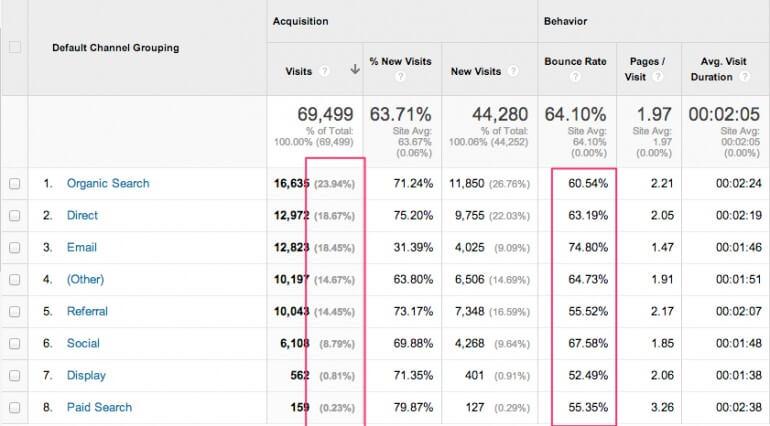 This report will give you a top-level view of where your traffic is coming from based on channel type. Take a close look at both acquisition details, and the associated behavior for each channel. Some channels may provide a large amount of traffic, with little action. Don't necessarily assume that the largest channel is the best.
One thing to pay close attention to is the bounce rate. If a visitor comes to your website and leaves without visiting an additional page, or is inactive on that page for more than 30 minutes, it’s considered a bounce. You want these numbers to be as low as possible. Page visits, and the average duration of visit are also very useful metrics for analyzing content quality.
To get a more detailed view of your traffic sources, you should take a look at your 'Acquisition > All Referrals' report. This will show you specific landing pages and sites that are linking to your site.
This report will give you a top-level view of where your traffic is coming from based on channel type. Take a close look at both acquisition details, and the associated behavior for each channel. Some channels may provide a large amount of traffic, with little action. Don't necessarily assume that the largest channel is the best.
One thing to pay close attention to is the bounce rate. If a visitor comes to your website and leaves without visiting an additional page, or is inactive on that page for more than 30 minutes, it’s considered a bounce. You want these numbers to be as low as possible. Page visits, and the average duration of visit are also very useful metrics for analyzing content quality.
To get a more detailed view of your traffic sources, you should take a look at your 'Acquisition > All Referrals' report. This will show you specific landing pages and sites that are linking to your site.
Visits Via Social Referral
One of the major traffic drivers that we can easily influence every month is traffic coming from various social networks. Google's new social analytics are excellent, and can be found under 'Acquisition > Social.' Under 'Acquisition > Social > Network Referrals' you will see a breakdown of social networks and their individual contributions to to traffic.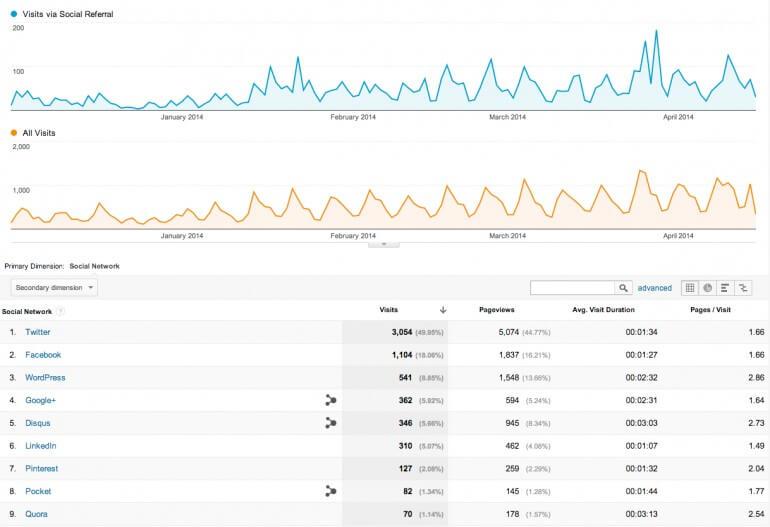 As before, you will want to pay particular attention to 'Avg. Visit Duration'. You should be able to determine which networks provide the greatest amount of traffic, and which ones create the most engagement with your content. Once you know this, incorporate your findings into your social media sharing schedule.
For a deeper look at how social visitors interact with your content, visit 'Acquisition > Social > Landing Pages.' This will show you what content is most popular on social media.
As before, you will want to pay particular attention to 'Avg. Visit Duration'. You should be able to determine which networks provide the greatest amount of traffic, and which ones create the most engagement with your content. Once you know this, incorporate your findings into your social media sharing schedule.
For a deeper look at how social visitors interact with your content, visit 'Acquisition > Social > Landing Pages.' This will show you what content is most popular on social media.
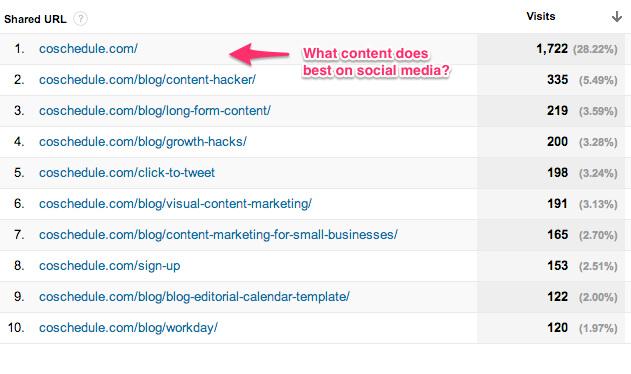 Follow-Up Questions to Ask Yourself:
Follow-Up Questions to Ask Yourself:
How does this compare to where I thought my traffic was coming from? Many times, we make big assumptions about where our traffic is coming from, and more importantly, the quality of that traffic. It is important to confront these biases with data so that we don't sell ourselves short.
Where are my biggest opportunities for traffic growth? Ultimately, every blogger wants more traffic. These reports should help you make some conclusions about that. If you see that Facebook is bringing good traffic with high engagement, then you might want to double your posting efforts, or work to increase they number of fans on your page.
#2: How Do New Visitors Come To My Site, And Why Do They Leave?
For writers and bloggers, our site is all about the content. What content are your visitors consuming when they come to your site? Google Analytics provides excellent data about your landing pages. Under 'Behavior > Site Content > Landing Pages' Google will provide you with a breakdown of your key landing pages and site sections. Make sure that you toggle the number of rows that are provided so that you can get a clear picture of your content. You should also be looking at where people are leaving your site. This can be found under 'Behavior > Site Content > Exit Pages.'
You should also be looking at where people are leaving your site. This can be found under 'Behavior > Site Content > Exit Pages.'
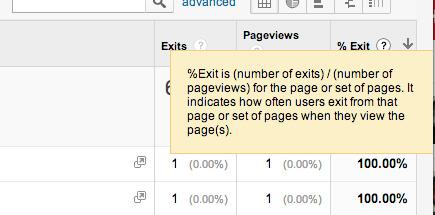 Exit pages indicate how often a user exits from the page they are visiting. Exiting is defined as leaving or becoming inactive on your site. If you see that a key landing page or blog post is garnering a large number of exits, it could be a sign that users weren't finding what they were looking for. This could be an indication that you are are targeting irrelevant topics or blog post keywords.
Exit pages indicate how often a user exits from the page they are visiting. Exiting is defined as leaving or becoming inactive on your site. If you see that a key landing page or blog post is garnering a large number of exits, it could be a sign that users weren't finding what they were looking for. This could be an indication that you are are targeting irrelevant topics or blog post keywords.
Follow-Up Questions to Ask Yourself:
What topics perform best for my visitors? By analyzing how people enter and leave your website, you should be able to get a good idea of what content people like best, and where they are coming from. For example, high-performing landing pages can signal strong performance on search engines. This can give you some ideas about future keywords to target or topics to cover.
Be sure to compare this to the data we looked at earlier. In question #1 we got an idea of what content will likely be shared on social media. How does that compare with the content that holds your visitor's attention the longest?
Are my landing pages garnering adequate visitor engagement? If you are creating key landing pages, or evergreen content on your blog, it would make a lot of sense to analyze those pages individually. Not only do you want to measure how often those pages are visited, but you should take a look at how long visitors stay, and how frequently they exit your page.
#3: How Do Visitors Experience My Site?
Google Analytics are included on every page of your site, so watching how a user interacts with your navigation and content is an important insight that you can garner from the data. The first thing to be aware of is the content drilldown tool available at 'Behavior > Site Content > Content Drilldown.' Here you will be able to drilldown to key landing pages in your site to see how traffic is directly affecting that page.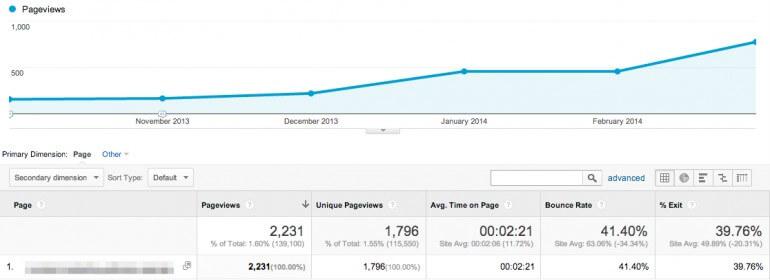 For example, we can see that this page has seen a steady traffic increase over that last several months with a spike in March. This is great, because it correlates to some improvements that were made to the page recently. We can also see that the bounce rate is very low, which is great news for our goal conversions.
If you want to see a more global picture of how users navigate your site, you can use the behavior flow chart located at 'Behavior > Site Content > Behavior Flow.'
For example, we can see that this page has seen a steady traffic increase over that last several months with a spike in March. This is great, because it correlates to some improvements that were made to the page recently. We can also see that the bounce rate is very low, which is great news for our goal conversions.
If you want to see a more global picture of how users navigate your site, you can use the behavior flow chart located at 'Behavior > Site Content > Behavior Flow.'
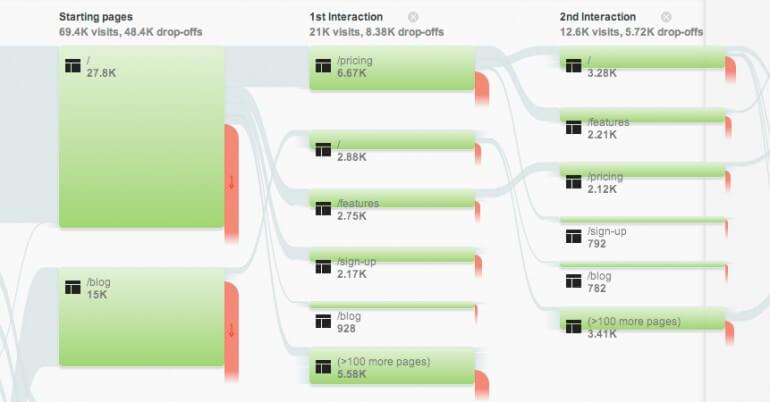 This interactive model will show you the most common traffic patterns coming to your site. For example, we can see here that users who arrive on our homepage typically visit the pricing page first, and then the features page. That makes a lot of sense, and it would be smart of us to think about that as we rework the copy and images on those pages.
Digging into your behavior flow show give you all kinds of clues about how users interact with your sites content. Be sure to click around the behavior flow model, as it is a fully interactive tool that will allow you to drill down several interactions.
This interactive model will show you the most common traffic patterns coming to your site. For example, we can see here that users who arrive on our homepage typically visit the pricing page first, and then the features page. That makes a lot of sense, and it would be smart of us to think about that as we rework the copy and images on those pages.
Digging into your behavior flow show give you all kinds of clues about how users interact with your sites content. Be sure to click around the behavior flow model, as it is a fully interactive tool that will allow you to drill down several interactions.
Follow-Up Questions to Ask Yourself:
What do most visitors see when they visit my site? Spend some time recreating your visitor's behavior flow on your own site. What is the experience like for those users? We often create pages individually, and fail to consider the story arc that is created across several pages. What happens when you read/view those pages as a group, or a story? You might discover some simple mistakes that could dramatically improve the experience for all visitors.
What pages are visitors not getting to? There may be some key pages on your site that your visitors are missing. Why? Now is a great time to start formulating some ideas and matching them to the data.
#4: How Well Does My Site Perform In Regard To My Stated Call To Action(s)?
Every page on your site should be driving itself to a specific call to action. What do you want your visitor to do? Options could include signing up for an email course, or downloading an ebook. Whatever it is, each page needs a goal and a method for measuring it. Google Analytics is an easy way to get this done.Setting Up A Goal In Google Analytics
The first thing that you will need to do is setup a goal in your Google Analytics account. Google's instructions outline this process very clearly. From Google:Goals are set at the view level. To find a view, click Admin, then select an account, property, and a view. Click Goals, then Create a Goal. Follow the step-by-step flow in your account to set up a Goal. As you complete each step, click Next Step to save and move on. Click Save Goal to finish. To quit the process without saving, click Cancel.
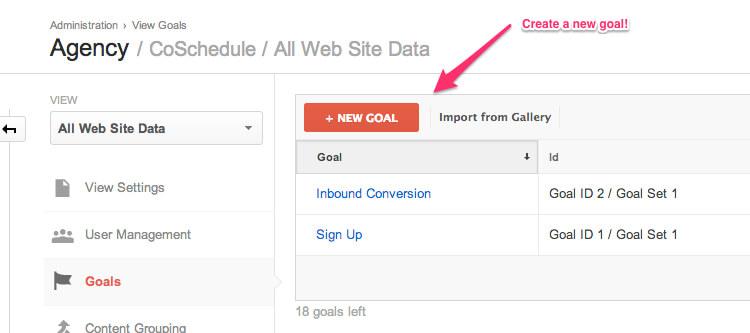 Goals can be created by destination (a specific page that the user visits), duration (amount of time spent on a page), number of visits to a page, or a specific event triggered through JavaScript (this is advanced, watch out). The most common type of goal is a 'destination' goal. This can be used for a sign up page or the thank you page of a contact form. Duration works great for lengthy landing pages or videos.
Once you have your goals set up visit 'Conversions > Goals > Overview' to see how they are performing. You can also visit 'Conversions > Goals > Goal Flow' to see how specific inbound traffic sources are influencing goal conversions. This is one of the most useful charts in goals section because it attaches actual conversion value to your inbound traffic sources.
Goals can be created by destination (a specific page that the user visits), duration (amount of time spent on a page), number of visits to a page, or a specific event triggered through JavaScript (this is advanced, watch out). The most common type of goal is a 'destination' goal. This can be used for a sign up page or the thank you page of a contact form. Duration works great for lengthy landing pages or videos.
Once you have your goals set up visit 'Conversions > Goals > Overview' to see how they are performing. You can also visit 'Conversions > Goals > Goal Flow' to see how specific inbound traffic sources are influencing goal conversions. This is one of the most useful charts in goals section because it attaches actual conversion value to your inbound traffic sources.
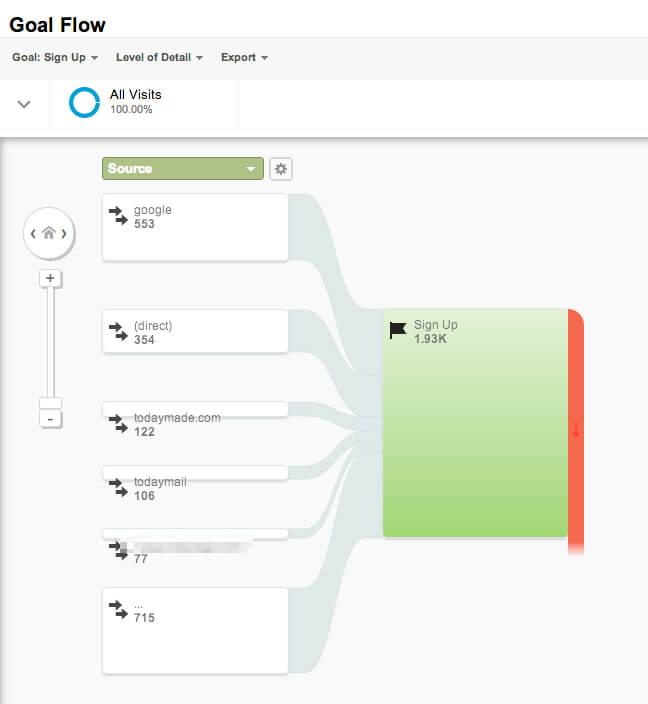 Chances are that you will need to jump through a few hoops to properly track your goals. This process can be tricky, but it can also be very valuable. Here's what Google has to say about setting up goals.
Chances are that you will need to jump through a few hoops to properly track your goals. This process can be tricky, but it can also be very valuable. Here's what Google has to say about setting up goals.
Follow-Up Questions to Ask Yourself:
Do my pages lead to a proper call to action? It can be valuable to think about your website as a series of landing pages, rather than a group of content. Awhile back I tried to define the perfect blog post, and one of the primary characteristics of the post was its focus on a single goal. If you could pick one thing for your visitor to do, what would it be? We often want to pick everything but doing that makes it impossible to actually track our results. Take some time to choose the one thing that actually brings your website value. Just a hint: the best call to actions usually include some kind of form for users to submit.
Are my call to actions measurable? Sometimes I hear writers choose call to actions that are very difficult to measure, like social shares (although it is possible) or blog comments. It is important to choose easily trackable CTAs. The easier they are to track, the more likely you are to follow through on their results.
#5: Is My Website Working Effectively?
In addtion to providing a great deal of information about your websites traffic, Google Analytics can also give you a pretty good idea of the health of your website. To do this, we look to three primary tools. To visualize how visitors navigate your page, and where they click, visit 'Behavior > In-Page Analytics.' Here you will be able to see actual click-throughs layered on top of your website design itself. This is an important tool for evaluating if the design/layout of your site is leading your users to the proper actions. You can also checkup on the speed of your site under 'Behavior > Site Speed,' or gather a few suggestions under 'Behavior > Site Speed > Site Speed Suggestions'. While many don't spend much time worrying about the speed of our website, it is an important factor that influences how a site is ranked on Google.
You can also checkup on the speed of your site under 'Behavior > Site Speed,' or gather a few suggestions under 'Behavior > Site Speed > Site Speed Suggestions'. While many don't spend much time worrying about the speed of our website, it is an important factor that influences how a site is ranked on Google.
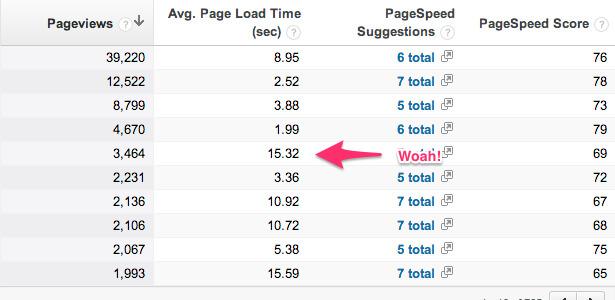
Follow-Up Questions to Ask Yourself:
Is my site navigation clear and well understood? Website navigation can be a major factor for new visitors when they come to your site. We often worry about new visitors being able to find our navigation, but there can also be situations were our navigation (or other ads/buttons) is actually distracting our users from the things that we want them to be doing. Watch for unusual hot-spots when monitoring how visitors navigate your page.
How do users react to slow page load times? Pay attention to how your navigate the web. Are you super patient and always willing to wait? Probably not. If a site doesn't load in a less than a few seconds we get antsy, and are more likely to leave. Don't let this happen to you. If nothing else, use Google Analytics to make some basic changes to your site and improve the overall speed and efficiency.
More Google Analytics Training: Here's How To Learn More
 Google Analytics help is very helpful. Don't miss it.
The thing to remember is that Google Analytics is not nearly as complicated as it looks. The charts, tables, and graphs can be very intimidating, but they don't have to be. Always remember that Google Analytics is full of basic helpers and tutorials that will guide you on your way. Be sure to keep an eye out for the 'Analytics Education' icon in the top right corner of the page. By clicking on it, you will be able to explore help videos, and find answers to common questions.
Google Analytics help is very helpful. Don't miss it.
The thing to remember is that Google Analytics is not nearly as complicated as it looks. The charts, tables, and graphs can be very intimidating, but they don't have to be. Always remember that Google Analytics is full of basic helpers and tutorials that will guide you on your way. Be sure to keep an eye out for the 'Analytics Education' icon in the top right corner of the page. By clicking on it, you will be able to explore help videos, and find answers to common questions.

